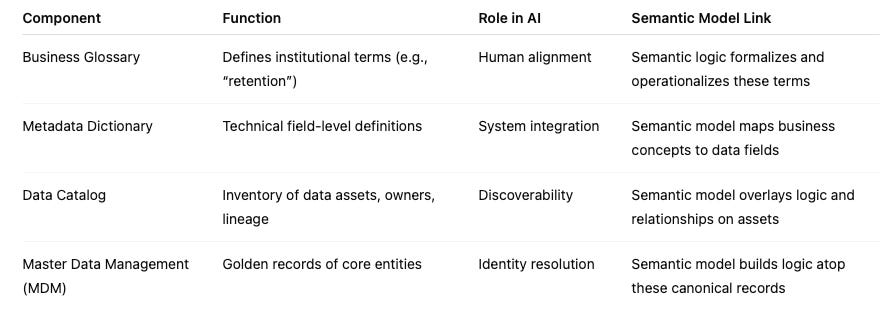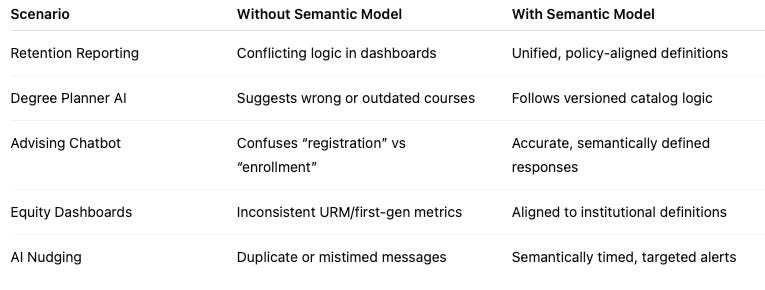The Semantic Model: The Hidden Backbone of AI and Data Readiness in Higher Education
Making Meaning Actionable Across Systems, Stakeholders, and AI
Why This Article Matters
As higher education rapidly embraces artificial intelligence, predictive analytics, and automation, the spotlight often falls on shiny tools—chatbots, dashboards, copilots, and vendor platforms like Salesforce, Oracle, and Workday. But beneath these visible innovations lies a quiet, invisible layer that determines whether those tools are trustworthy, ethical, and effective: the semantic model.
The semantic model is the foundation that defines shared meaning across systems, aligns policies with technology, and enables machines to reason with context—not just data. Without it, institutions risk scaling misinformation, increasing ethical risk, and fragmenting decision-making across silos.
This article is your comprehensive guide to understanding what a semantic model is, why it matters, how it connects to data governance and AI, and how to build one in practice. It is written for higher ed leaders, data architects, AI strategists, institutional researchers, and governance professionals who seek to build systems rooted in meaning, not just functionality.
What Is a Semantic Model?
Before machines can act intelligently, they must understand context. A semantic model provides that understanding by representing the core concepts, relationships, and logical rules that define an institution’s reality.
It describes:
What key entities (e.g., Student, Course, Program) mean
How those entities relate to each other
How data fields across systems map to these concepts
What logic should govern institutional actions
It is not a data warehouse. It is not a technical schema. It is a conceptual and computational model of meaning that powers AI, reporting, and decision-making with integrity and consistency.
Think of it as the institutional brain that connects data to understanding.
The Semantic Model as a Pillar of Data & AI Readiness
Data readiness is more than technical infrastructure. It’s about whether your institution’s data can be trusted, understood, and used responsibly by humans and machines alike.
The semantic model plays a pivotal role in institutional readiness by providing meaning-based scaffolding that enhances every other part of the data and AI stack.
Six Core Functions of a Semantic Model in a Higher Ed Ecosystem
Each of the following functions explains how semantic modeling supports a more coherent, ethical, and effective data and AI ecosystem. These are not optional side benefits—they are essential to creating systems that serve students, faculty, and administrators responsibly.
1. Unifies Institutional Meaning Across Silos
In most institutions, different departments use different definitions for the same concepts. Retention might mean something slightly different to Institutional Research, the Registrar, and Student Affairs. These semantic mismatches lead to inconsistent reporting, conflicting interventions, and distrust in analytics.
A semantic model aligns these concepts institution-wide.
📌 Example:
“Retention” = Re-enrollment in the subsequent fall term among first-time, full-time, degree-seeking undergraduates. This becomes a machine-readable definition enforced across all tools and systems.
2. Enables Cross-System Reasoning and Interoperability
Modern campuses operate a patchwork of systems: SIS, LMS, CRM, advising platforms, financial aid tools, and more. Each uses its own schema and definitions, making cross-system AI or analytics nearly impossible.
A semantic model bridges these silos with shared logic.
📌 Example:
“Student.Engagement_Score” is semantically composed of data from Canvas (login frequency), Salesforce (event attendance), and DegreeWorks (missed advising sessions).
3. Supports Ethical and Governed AI
AI is only as ethical as the data and logic behind it. If sensitive attributes like race, income, or disability status are used without proper controls—or if bias is baked into definitions—then AI becomes a risk rather than a resource.
Semantic models enforce policy-aligned logic and data usage constraints.
📌 Example:
“First-generation student” is defined using verified admissions fields, not inferred by ZIP code, high school, or text embeddings—avoiding unethical proxy inference.
4. Improves Data Quality, Accuracy, and Trust
Data pipelines often treat fields as interchangeable variables. But meaning matters. “Units completed” vs “Units attempted” can lead to major analytical missteps.
Semantic models expose and enforce the correct interpretation of each field.
📌 Example:
A rule like “Student GPA must range between 0.0 and 4.0 and exclude Pass/No Pass grades unless flagged” becomes part of the system logic, not just a footnote in a data dictionary.
5. Enables Explainable and Transparent AI
Explainability is critical in higher education, where predictive analytics impact real lives. Faculty and advisors need to know why a model flagged a student—not just what it concluded.
Semantic modeling connects AI outputs to human-readable reasoning.
📌 Example:
“Risk Score = GPA < 2.0 + missed Canvas sessions + no advising visit in 60 days.” Each signal is traceable to governed, semantically defined inputs.
6. Drives Human-Machine Collaboration
AI is not replacing humans. It’s partnering with them. But that only works if systems and stakeholders speak the same language. Semantic models create a shared logic layer that enables human-aligned dashboards, chatbots, and decision-support tools.
📌 Example:
“On-track to graduate” is defined once and used in DegreeWorks, Tableau dashboards, AI nudges, and advising copilots.
Relationship to Data Catalog, Business Glossary, Metadata Dictionary, and MDM
Semantic modeling doesn't replace traditional data assets—it activates them. Here's how they interact:
Semantic models turn these documentation tools into living, reasoning engines.
Architecture: Where the Semantic Model Lives
Understanding where semantic modeling fits helps clarify its strategic role. It’s not just one more tool—it’s the meaning layer that activates your data and AI stack.
🧰 Use Case Table – With vs. Without Semantic Model
How Semantic Modeling Fits into Data Governance
Data governance is often framed in terms of stewardship, access, and policy. But enforcement often lives in documentation, not systems. Semantic modeling turns policies into logic—making governance executable.
Operationalizes Policy Logic
Turns terms like “academic standing” into actual system logic
Makes FERPA rules machine-enforceable
Aligns AI behavior with DEI commitments
Enables Stewardship and Ownership
Assigns logic stewards to definitions and relationships
Enables audit logs and version history for terms like “on-track”
Tracks usage of definitions across systems and dashboards
Connects Governance to Action
Dashboards, models, and AI agents all draw from the same rules
Prevents logic drift and rogue scripts
Provides a living contract between policy and practice
📌 Example:
“Risk model may only use attributes A, B, and C. These attributes are flagged as ‘AI-safe’ in the semantic model and governed by data policy D.”
How Semantic Modeling Is Done (Technically and Practically)
Understanding how to build a semantic model turns strategy into execution. Here’s how campuses do it:
Step 1: Identify Core Domains
Begin with high-value areas:
Student success
Academic planning
Enrollment management
Equity analytics
Financial aid risk
Step 2: Define Canonical Entities
List key entities and their attributes:
Student: ID, status, GPA
Course: code, credits, modality
Program: degree level, requirements
Instructor, Term, Session
Step 3: Model Relationships
Define how entities interact:
Student → EnrolledIn → Course
Program → Requires → CourseGroup
Course → HasPrerequisite → Course
Use:
RDF/OWL (machine-readable semantic web standards)
Graph modeling (Neo4j, Stardog)
SHACL/JSON-LD for constraint logic
Step 4: Map Concepts to Systems
Link abstract concepts to real fields:
Student.Status → SIS field
stdnt_status_cdCourse.Modality → LMS
delivery_methodRiskScore → model output using semantically governed inputs
Tools:
Collibra, Alation, Atlan (metadata)
Protégé (ontology modeling)
Custom semantic layers using SQL/SPARQL
Step 5: Create Semantic Views
Deploy logic into usable formats:
SQL views for dashboards
GraphQL interfaces for AI agents
SPARQL endpoints for knowledge graphs
Virtualized data layers for federated querying (e.g., Denodo)
Step 6: Integrate with AI and BI Tools
Use LangChain or Semantic Kernel to embed rules into AI prompts
Use semantic tags in vector databases for context-aware retrieval
Use structured logic for explainable AI inference chains
Step 7: Operationalize Through Governance
Assign ownership to each concept and rule
Version logic changes and impact assessments
Monitor usage of semantic definitions across systems
Summary: Why You Need a Semantic Model
Without a semantic model, AI is fragmented, dashboards conflict, and governance stays on paper.
Conclusion
The semantic model is the missing foundation for truly intelligent, ethical, and explainable systems in higher education. It is what enables a chatbot to give consistent advice, a dashboard to reflect institutional truth, and an AI model to align with policy and equity.
While many institutions focus on tools and platforms, those that succeed in scaling AI and analytics will be the ones that invest in shared meaning. A semantic model isn’t just another layer—it’s the glue that connects people, systems, policies, and technology.
It’s not enough to ask, “What does the data say?”
In the age of AI, we must also ask:
“What does the data mean?”
And we must ensure that everyone—humans and machines—has the same answer.






